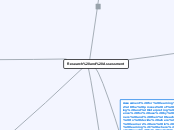jonka Oulla Ali 6 vuotta sitten
92
EDUC 5013Q Mindmap
In the educational setting, grading should be based on clear, well-established criteria, ensuring that every piece of accumulated evidence is considered. Teachers must provide pertinent feedback, helping students understand their learning progress and areas needing improvement.









